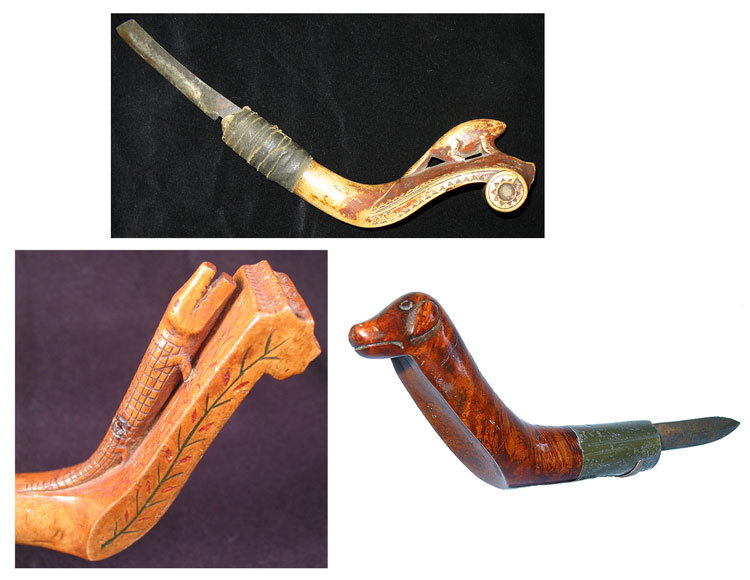Figural Crooked Knife
Crooked knives are multi-purpose tools that were made and used by Woodlands Indians as early as the 1600s. They were documented by explorers, traders and missionaries as one of the most essential tools of “the Man of the North.”
Woodlands tribes include those in the Northeast (Maine and the Maritime Provinces) such as Micmac, Penobscot, Maliseet and Passamaquoddy, and those in the Eastern, Central and Western Great Lakes regions such as Iroquois, Huron, Cree, and Chippewa.
The circa 1880 Northeastern Woodlands Indian crooked knife pictured here has a handle carved in the shape of a curled human hand, exemplifying the blend of function and artistic expression that elevates embellished crooked knives beyond the status of an everyday tool.
An excellent book, “Mocotaugan: The Story and Art of the Crooked Knife” (2003) by Russell Jalbert & Ned Jalbert (available as a pdf at mocotauganthebook.com), describes the crooked knife being used for everything from making wood shavings for fire starter to shaping ax handles, wigwam poles, storage vessel, snow shoes, canoe paddles, and birch bark canoes.
The unique angle at which the blade is set into the handle earned this knife the name “crooked.” The blade is positioned so that the grip can be grasped with the thumb placed under the handle, allowing for a powerful stroke as the knife is drawn across wood towards the body.
Indians were adept at recycling useful materials, and often repurposed steel from a straight razor or a file to serve as the knife blade. In our example, the knife is secured to the handle with a harness of inlaid lead or pewter, but often blades are held with leather or wire wrap.
Not all crooked knives were elaborately carved. Utilitarian knives with simple handles would have been among the several crooked knives a woodsman typically owned. This unpublished photo from circa 1880 of a group of Cree Indians in Quebec shows three men (sitting at far right, sitting center front, standing in back near the tent opening) using their everyday crooked knives to shape canoe paddles.
But even the most decorative knives were put to use, according to Jalbert & Jalbert. The decoration was positioned above the grip so it did not interfere with the function of the knife, and also so that it remained in view while the knife was being used, serving as a testament to the artistic talents and vision of its maker.
Although it can be hard to make a definitive attribution of individual crooked knives to a particular tribe, Jalbert & Jalbert make some distinctions among the decorative styles of different regions. Northeastern Woodlands knives tended to have short blades, compact handles, and squared edges. These features, along with documentation of the curled hand as a motif on Northeastern crooked knives, leads us to attribute the knife we have to a Maine or Maritime Indian carver.
The photo below is from anthropologist Frank Speck’s 1940 book “Penobscot Man” which documents the research he conducted on Penobscot material culture during his many years living among the tribe. The two knives on the left are unadorned crooked knives, the one on the right middle has a slight scroll design, and the one on the right has a handle in the shape of a human hand.
Jalbert & Jalbert group the range of traditional Woodlands “small scale sculpture” found on crooked knives into nine design categories, among which are human and animal effigies, chip carving, and scrolls. While our hand knife would be categorized as a human effigy, other knives we have sold in the past have had animal effigies, including a beaver, an alligator, and a dog, pictured below. The beaver knife also shows two other traditional design elements: chip-carving and scrolled ends.
There is nothing quite like holding a crooked knife that is over 100 years old and feeling how naturally it is gripped and drawn. These knives speak of the basics of survival in the bush using one’s hands and a multi-purpose tool – both quite literally represented in our carved hand knife. Embellished crooked knives also speak of how the human artistic impulse and urge for self-expression can imbue an inanimate object with an enduring spirit.























